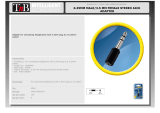
www.PyleUSA.com
3
3. MIC 1 & MIC 2 Jack: Allows you to connect up to two 6.35mm type microphone.
4. LED Level Display Meter
5. Three Input Sources Mixing Controls: Controls the sound level for each of the
audio input sources.
PHONO/AUX: Select and connect an alternative high level (AUX/CD) or low
level (PHONO) audio sound source.
6. AUX-IN: Input to connect an external audio device
7. BASS: Increases or reduces the bass frequencies of the signal
8. MID KNOB: Increases or reduces the mid-low frequencies of the signal
9. HIGH KNOB: Increases or reduces the high frequenciess of the signal
10. MASTER VOLUME: Controls the overall volume of the amplier
11. SD Card Input
12. USB Flash Drive Input
13. LED Display: Displays the output level and selected input
14. MODE, PLAY, PREV and NEXT Function Control buttons:
• MODE Button: For audio selection like WIRELESS BT/SD/LINE IN
• PLAY/PAUSE BUTTON: Play and Pause control button
• PREV/NEXT: Quick backward or next song
15. Voltage Selector: Select the voltage of AC power input source. The amplifer
has selectable input voltage from 110V/60Hz which is the standard in USA and
CANADA. You can also switch the input voltage to 230V/50Hz for EUROPEAN
operation. Please make sure the switch is in the proper position before operating
otherwise severe damage will result which is not covered by the warranty.
Please also replace the fuse with proper rating in this situation.
16. Push-Terminal Connectors: Let you easily connect speaker wires directly to
the ampliers.
17. AC INPUT
18. Unswitched AC Accessory Outlet: 300W MAX.
19. PHONO and AUX/CD Input Selector: Lets you select the input source you
want to connect to the amplier.
20. PHONO Input Jack: You can connect a low level audio input source, such as a
magnetic cartridge turntable to the L PHONO and R PHONO jacks.
21. PHONO and AUX/CD Input Selector: Lets you select the input source you
want to connect to the amplier.
22. MIX BUS Jack: Allows you to connect another PT210 to this jack to double the
size of your PA system.


















